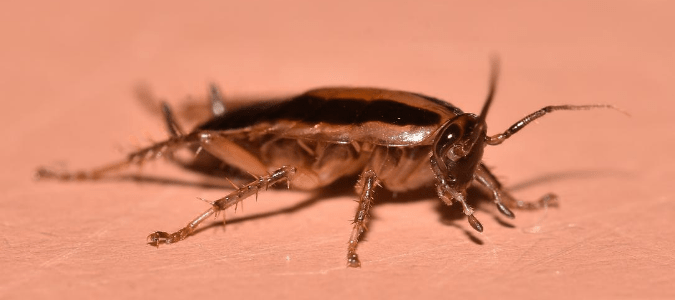It can be frustrating to see baby roaches scurrying around your home after you’ve had an extermination. You might be wondering why this is happening, especially if you thought the extermination would solve your roach problem. Unfortunately, there are several reasons why you might still be seeing baby roaches after an extermination.
One of the most common reasons is incomplete extermination practices. If the exterminator didn’t properly treat all areas of your home or missed some roach eggs, then baby roaches could still hatch and roam around. Additionally, some extermination methods might not be effective against baby roaches, which means they could survive and continue to breed.
Another reason for baby roaches reappearing after extermination is due to attractants and conducive conditions. If you have food and water readily available for roaches, then this could encourage them to breed and thrive despite the extermination efforts. Similarly, if your home has cracks or crevices that provide a breeding ground, then the roaches could continue to multiply.
Overall, there are several reasons why you might still be seeing baby roaches after an extermination. Understanding these reasons and taking action to address them can help you get rid of these pests for good.
Key Takeaways:
- Incomplete extermination practices can result in baby roaches surviving and breeding.
- Attractants and conducive conditions can encourage roaches to thrive despite extermination efforts.
- Identifying and addressing the root cause of the roach problem can help prevent baby roaches from reappearing.
Understanding the Life Cycle of Roaches
To understand why baby roaches reappear after extermination, you need to know the life cycle of roaches. Roaches go through three stages in their life cycle: egg, nymph, and adult.
The female roach can lay up to 40 eggs at once, which are called an ootheca. The capsule-like structure contains several eggs inside and can be carried by the female roach for several days before being deposited in a safe place. Once hatched, the nymphs emerge and resemble adult roaches in shape but are smaller in size.
Nymphs molt, shedding their exoskeletons several times before reaching adulthood, and each stage of molt is called an instar. The time it takes for a roach to molt depends on various factors, including species, temperature, and availability of food. Once the roach reaches adulthood, it can live up to a year or more, depending on external factors.
The cycle continues as adult roaches mate and lay eggs, leading to a never-ending infestation if left untreated. This is why it’s important to address the issue of baby roaches reappearing after extermination by tackling the root cause of the infestation.
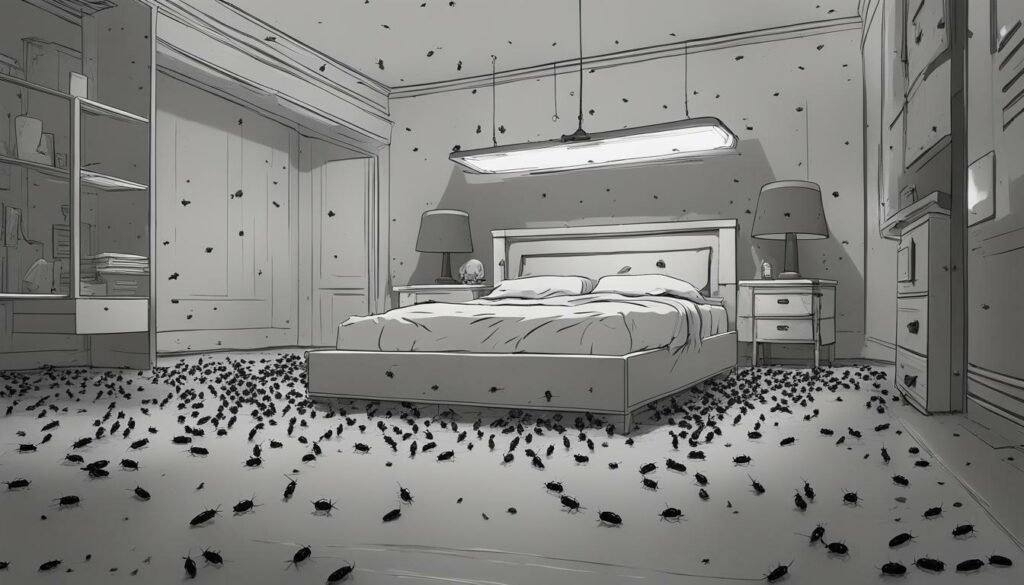

Knowing the life cycle of roaches and what drives their reproduction is essential in effectively dealing with a roach infestation. In the next section, we’ll explore some reasons why baby roaches may reappear after extermination and how to prevent this from happening.
Incomplete extermination practices
It can be frustrating to see baby roaches reappear after what you thought was a successful extermination. One possible reason for this is incomplete extermination practices. If the exterminator is not thorough in their treatment, some roaches, including eggs, may survive and continue to breed.
If you have noticed baby roaches after extermination, it’s important to take action to address the issue. You can start by contacting the exterminator to discuss the situation and ask if they can return to provide additional treatment.
In the meantime, here are some DIY methods to try:
| Method | Description |
|---|---|
| Boric acid | Mix boric acid with sugar and place the mixture in areas where roaches have been spotted. The sugar attracts the roaches, and the boric acid kills them. |
| Glue traps | Place glue traps in areas where roaches have been seen. The roaches become stuck to the adhesive on the trap and cannot escape. |
| Catnip | Catnip contains a natural insecticide that can repel roaches. Place small sachets of catnip in areas where roaches are present. |
While these DIY methods may provide some relief, they are not a substitute for professional extermination. It’s still important to address the root cause of the infestation to prevent baby roaches from reappearing.
Next, let’s explore some possible reasons why extermination may not have eliminated baby roaches.
Attractants and Conducive Conditions
Even after extermination, there may still be attractants and conducive conditions for baby roaches to reappear. One of the most common reasons for this is improper sanitation. Leftover food crumbs and spills should be cleaned up immediately as they can attract roaches. Ensure that all food is stored in sealed containers, and all trash is disposed of properly.
Another common attractant for roaches is moisture. Leaky pipes, dripping faucets, and standing water provide a perfect environment for roaches to thrive. It is essential to fix any water leaks and dry any standing water in and around your home.
Cracks, crevices, and cluttered areas also provide hiding places and breeding grounds for roaches. Seal any cracks and crevices in walls, floors, and foundations to prevent roaches from entering your home. Remove clutter and unnecessary items to eliminate hiding places for roaches.
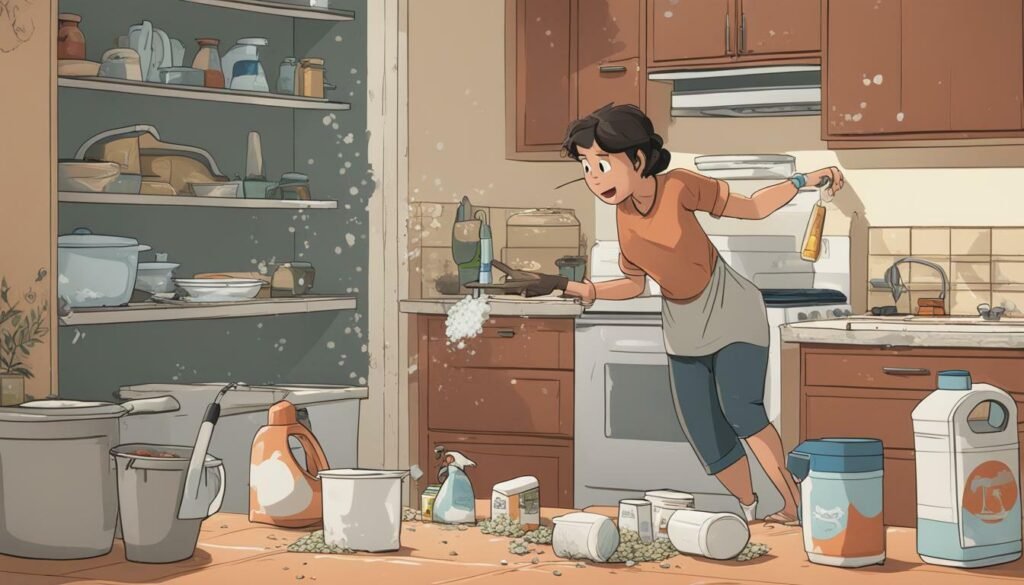

Regular cleaning and maintenance are crucial to preventing baby roaches after extermination. Regularly vacuuming and sweeping your home can help remove any stray crumbs or food particles. Deep cleaning frequently used areas, such as the kitchen and bathroom, can also help prevent roaches from reappearing.
It is also essential to inspect neighboring areas such as shared walls, basements, and attics. A hidden infestation in these areas can easily spread to your home, making it difficult to eliminate roaches.
By eliminating attractants and conducive conditions, you can prevent baby roaches from reappearing after extermination. Regular maintenance and proper sanitation are key to keeping your home roach-free.
Hidden infestations and neighboring areas
Despite extermination efforts, you may still find baby roaches in your home. This could be due to hidden infestations or neighboring areas.
Hidden infestations occur when roaches are able to find shelter in difficult-to-reach places such as cracks, crevices, and wall voids. These areas may have been overlooked during extermination or may have been inaccessible at the time. It’s important to address these areas by sealing cracks and crevices with caulk or foam, and removing clutter and debris to eliminate hiding spots.
Neighboring areas can also contribute to ongoing roach problems. If your neighbors have not addressed their roach infestations, it’s possible for roaches to migrate into your home. Additionally, if shared walls or pipes are not properly sealed, roaches can easily move between units. It’s important to communicate with your neighbors about any pest problems and work together to address them.
To prevent baby roaches from reappearing after extermination, it’s important to address both hidden infestations and neighboring areas. By sealing off entry points and eliminating hiding spots, you can prevent roaches from entering and find relief from these unwanted pests.
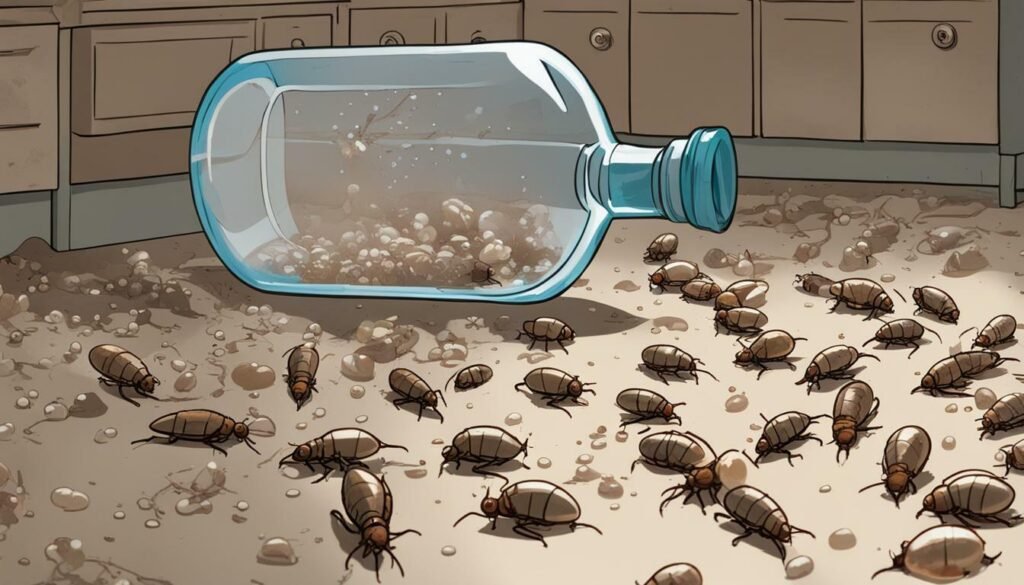

DIY methods to tackle baby roaches
If you’re dealing with baby roaches after extermination, you may be wondering how to get rid of them on your own. Here are some DIY methods to try:
Clean, clean, clean
One of the most effective ways to prevent baby roaches from reappearing is to keep your home clean and free from crumbs and debris. Make sure to regularly sweep, mop, and vacuum all areas of your home, especially the kitchen, and seal up any food containers or bags.
Set up sticky traps
Sticky traps can be a great way to catch baby roaches and monitor the extent of your infestation. Place them near areas where you’ve seen baby roaches, such as under sinks or behind appliances.
Use boric acid
Boric acid is a natural insecticide that is safe for humans but deadly to roaches. You can sprinkle it along baseboards and in cracks and crevices where baby roaches might be hiding.
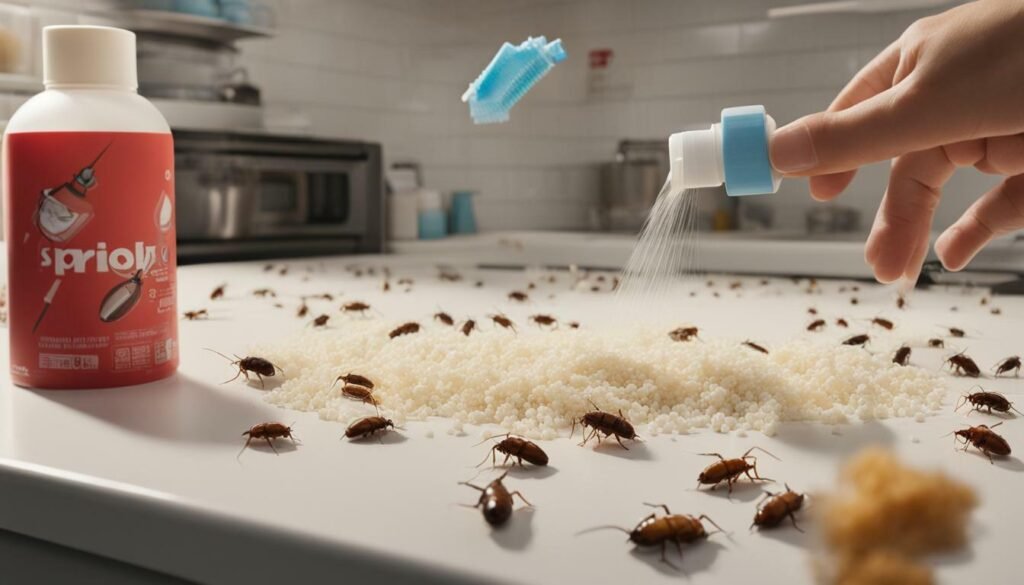

Make a homemade roach bait
Combine equal parts boric acid, flour, and sugar, and mix in enough water to make a dough. Roll the dough into small balls and place them in areas where you’ve seen baby roaches. They’ll eat the bait and take it back to their nest, where it will kill other roaches as well.
Remember, DIY methods may not always be as effective as calling in professional help, especially if your infestation is particularly severe. However, these methods can be a good starting point for preventing baby roaches from reappearing in your home.
Calling professional help
If you have followed all the DIY methods mentioned above, but the baby roaches keep reappearing after extermination, it’s time to call for professional help. A professional exterminator has the expertise and advanced tools to eliminate baby roaches and prevent them from returning.
Extermination companies use various techniques such as fumigation, baits, and sprays to get rid of the baby roaches. They also provide long-term prevention plans to keep your home baby roach-free. Professional extermination is especially necessary if you have a severe infestation or if the baby roaches keep reappearing after extermination.
Don’t let baby roaches cause havoc in your home. Contact a reliable extermination company to get rid of baby roaches after extermination and prevent their return. Remember, prevention is always better than cure!
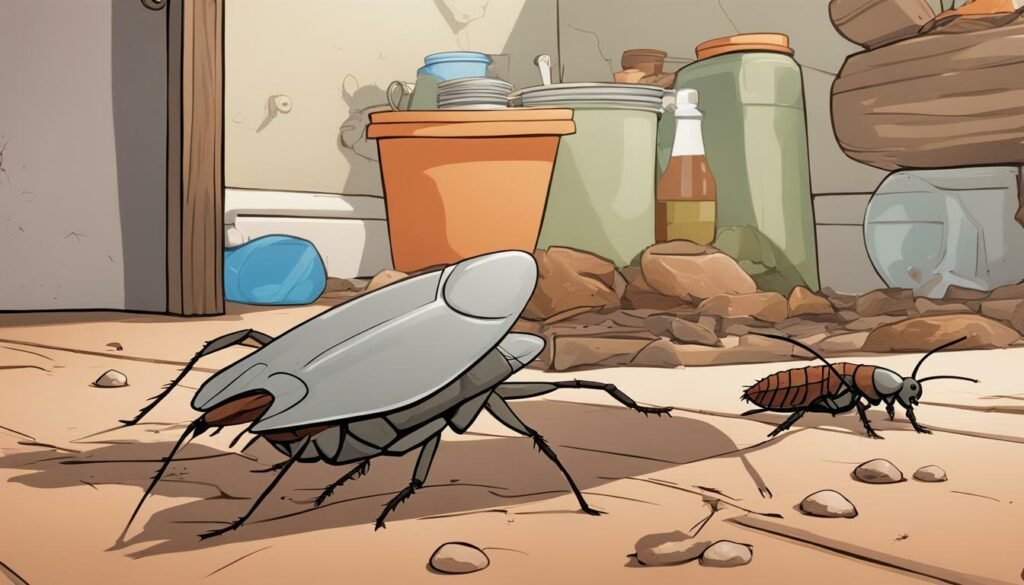

Maintenance and long-term prevention
Keeping your home clean and free of food debris and water sources is the best way to prevent baby roaches from reappearing after extermination. Remember, roaches are attracted to crumbs and spills, so wipe down counters and floors regularly, and store food in airtight containers.
Additionally, seal any cracks or openings in walls, baseboards, and doorways to prevent roaches from entering your home. You can use caulk or weather stripping to seal these gaps.
If you have a trash can inside your home, make sure to take out the garbage regularly and keep the can clean. Roaches are also attracted to moist environments, so be sure to fix any leaky pipes or faucets and dry up any standing water.
Another way to prevent baby roaches after extermination is to eliminate any other attractants in your home. This can include pet food, dirty dishes left in the sink, or clutter that can serve as hiding places.
If you live in an apartment or have neighbors close by, it’s also important to ensure that roaches are not present in any adjoining units or areas. Talk to your landlord or property management if you suspect a larger infestation.
In summary, preventing baby roaches after extermination involves maintaining a clean and dry environment, sealing any openings in your home, and eliminating attractants. By following these steps, you can keep your home roach-free for the long term.
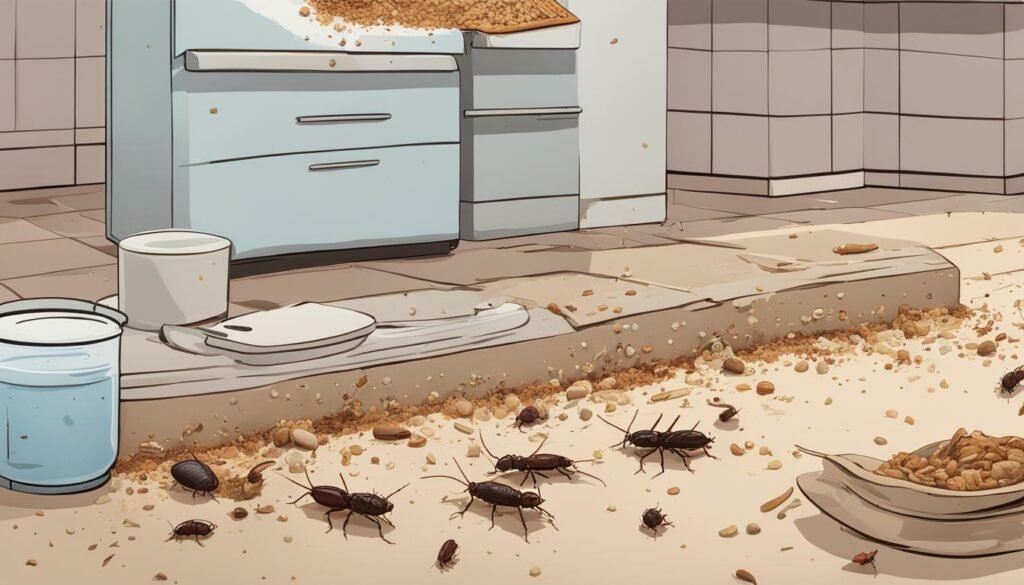

Conclusion
Dealing with baby roaches after extermination can be frustrating, but it’s important to understand that there are several reasons why they may reappear. By taking the necessary steps to prevent reinfestation, you can get rid of baby roaches for good.
If you suspect incomplete extermination practices, it’s best to call in professional help. DIY methods are useful, but they may not be enough to tackle hidden infestations or neighboring areas. Furthermore, maintaining a clean and hygienic environment is crucial in preventing baby roaches from coming back.
Remember, prevention is key. Identifying attractants and conducive conditions and taking steps to eliminate them can go a long way in preventing future infestations. By following these tips and seeking professional help when necessary, you can keep your home roach-free.
FAQ
Q: Why am I seeing baby roaches after extermination?
A: Seeing baby roaches after extermination can be due to a few reasons. It is possible that the extermination did not fully eliminate the infestation, and some baby roaches survived. Additionally, if the pest control measures did not address conducive conditions or hidden infestations, the baby roaches may reappear. Attractants such as food debris or moisture can also contribute to their presence.
Q: What is the life cycle of roaches?
A: Understanding the life cycle of roaches is important to tackle the issue effectively. Roaches go through egg, nymph, and adult stages. The nymphs are the baby roaches, and they can molt several times before becoming adults. This life cycle means that even if you eliminate adult roaches, there could still be baby roaches that will grow into new adults if not addressed.
Q: What can cause incomplete extermination practices?
A: Incomplete extermination practices can happen if the pest control measures only target adult roaches and neglect eggs and nymphs. If the infestation is extensive, it may require multiple treatments to fully eliminate all stages of roaches. Lack of proper follow-up or inadequate application of pesticides can also contribute to incomplete extermination.
Q: What can attract baby roaches after extermination?
A: After extermination, certain factors can attract baby roaches back into your space. This includes leaving out food or water sources, not properly cleaning up crumbs or spills, and having damp or humid conditions. Baby roaches are attracted to these environments and will be more likely to reinfest if such conditions are present.
Q: Can hidden infestations or neighboring areas cause baby roaches to reappear?
A: Yes, hidden infestations within walls, cracks, or other hard-to-reach areas can contribute to the reappearance of baby roaches. If neighboring areas, such as adjoining apartments or houses, have untreated roach problems, the pests can easily migrate back into your space. It is important to address these potential sources of infestation to prevent baby roaches from returning.
Q: What are some DIY methods to tackle baby roaches?
A: If you are dealing with baby roaches after extermination, there are several DIY methods you can try. These include thorough cleaning and sanitation practices, sealing entry points, reducing moisture levels, and using roach baits or traps. However, it is important to note that DIY methods may not always be sufficient, especially for severe infestations.
Q: When should I call professional help?
A: If your efforts to eliminate baby roaches after extermination are not successful or the infestation is severe, it is recommended to call professional pest control services. Professionals have the expertise and specialized treatments to effectively eliminate roach infestations and prevent their return. They can also assess and address any underlying issues that may be contributing to the problem.
Q: How can I maintain long-term prevention of baby roaches?
A: To prevent baby roaches from reappearing after extermination, it is essential to maintain good hygiene practices, such as regular cleaning, keeping food tightly sealed, and eliminating standing water or moisture sources. Sealing any entry points and addressing conducive conditions like cracks or leaks can also help prevent roaches from returning. Regular pest inspections and professional maintenance treatments can provide additional long-term prevention.
Your Expert in Animal Control and Extermination. Trust our experience for humane, effective pest management, protecting your property and ensuring peace of mind with Michael S.





